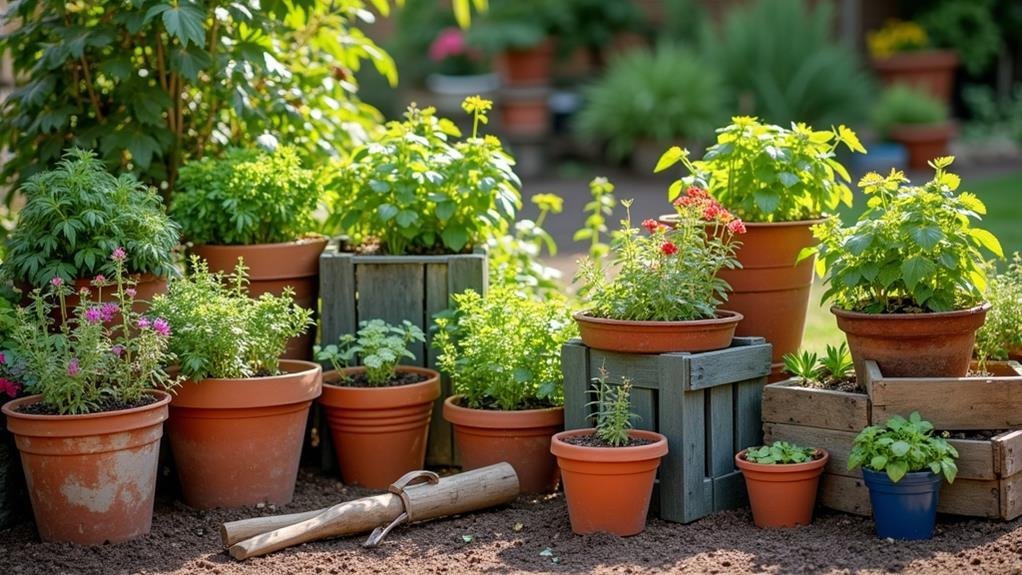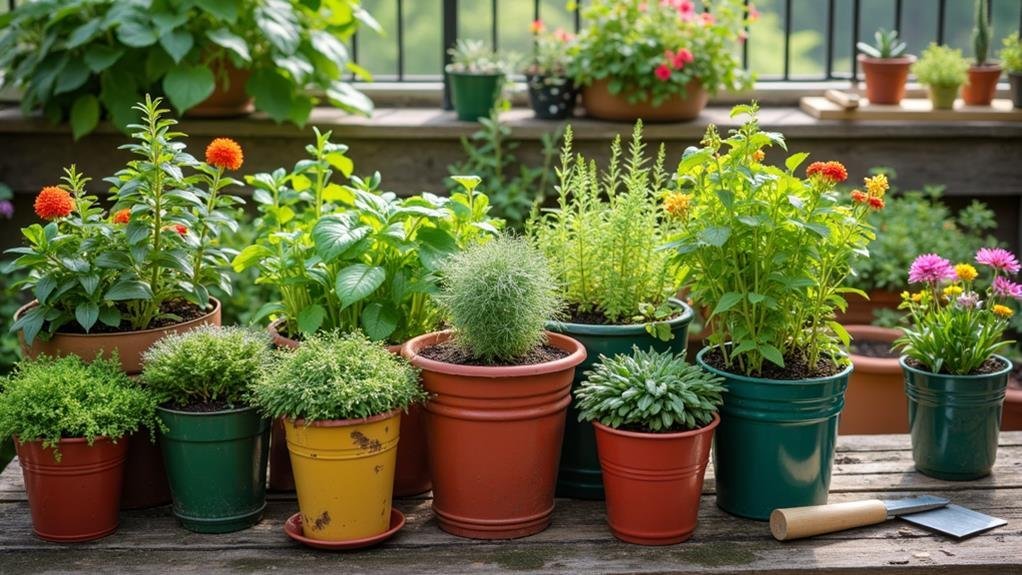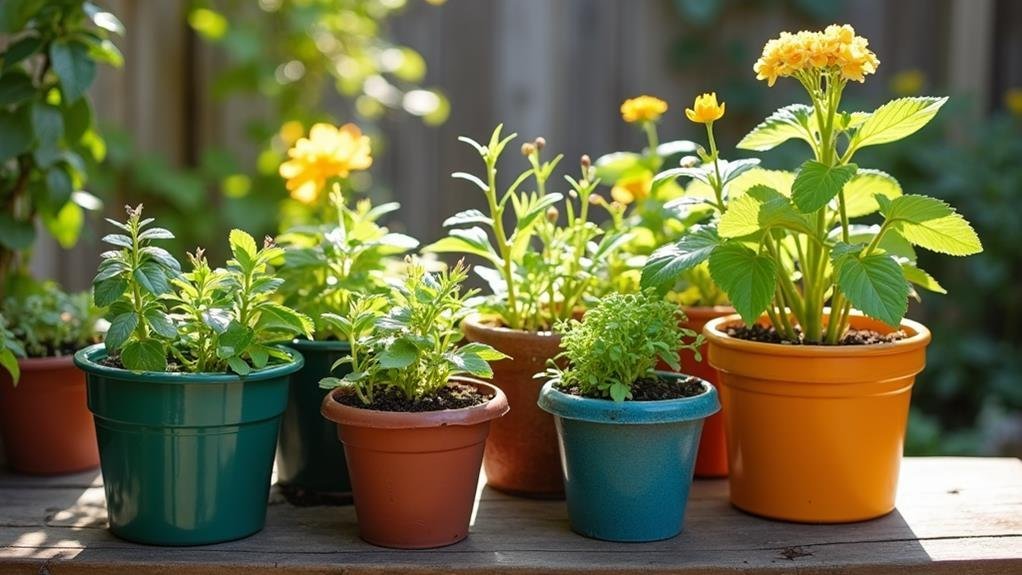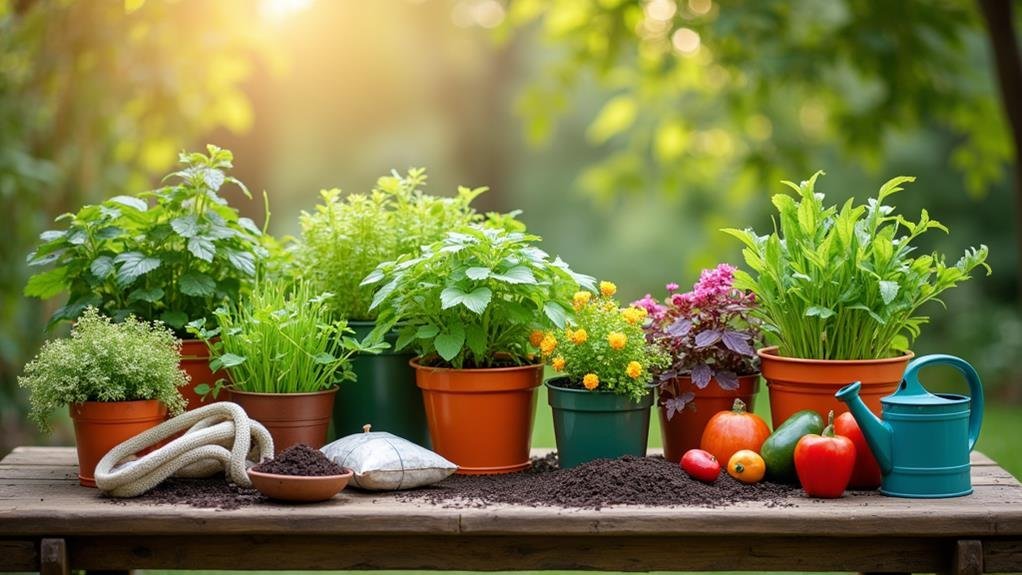If you're looking to start container gardening without breaking the bank, you might want to reflect on a few practical tips that can make a difference. Choosing the right containers can not only save you money but also add a unique touch to your garden. Pair that with quality soil and thoughtful plant selection, and you're already on your way to success. But there's more to it than just that; understanding how to maximize your resources can enhance your gardening experience. Curious about some innovative, low-cost strategies that can transform your outdoor space?
Choose the Right Containers

In relation to container gardening, selecting the right containers is essential for your plants' health and growth.
You'll want to take into account various factors, including size, material, and drainage. First, choose a container that's large enough for the type of plants you're growing. Smaller containers can restrict root growth, while larger ones may retain too much moisture for certain plants.
Next, think about the material. Plastic containers are lightweight and affordable, making them easy to move. However, clay pots are porous and allow for better air circulation, which can benefit your plants. Just remember, they can be heavier when wet!
Lastly, make sure your chosen containers have proper drainage holes. Without them, excess water could accumulate, leading to root rot.
If you're feeling creative, think about repurposing items like old buckets or wooden crates. They can add character to your garden while being budget-friendly.
Soil and Drainage Solutions
Choosing the right containers sets the stage, but soil and drainage play an essential role in your container garden's success. You need to start with a high-quality potting mix, which is specifically designed for containers. Unlike garden soil, potting mix provides better aeration and drainage, helping your plants thrive. Look for blends that contain peat moss, vermiculite, or perlite for best results.
Next, verify your containers have proper drainage holes. Without them, excess water can accumulate, leading to root rot. If your container doesn't have holes, consider drilling some or using it as a decorative outer pot. You can place smaller pots inside larger ones, creating a visual appeal while maintaining drainage.
Adding a layer of gravel or small stones at the bottom of your container can further improve drainage. This simple step prevents soil from clogging the holes, allowing water to escape freely.
Lastly, don't forget to monitor your plants' moisture levels. Containers can dry out quickly, so check the soil regularly and water as needed.
With the right soil and drainage solutions in place, you're well on your way to a flourishing container garden.
Affordable Plant Options

With regard to filling your containers with vibrant life, you don't have to break the bank. Start by considering herbs like basil, mint, or parsley. These not only add flavor to your meals but are often available at reasonable prices, especially if you buy them as seedlings.
Next, look into annual flowers like marigolds or petunias. They flourish in containers and can often be found at local nurseries or farmers' markets for a steal. Plus, their bright blooms will instantly uplift your space.
If you're aiming for a more sustainable approach, consider propagating plants from cuttings. Many succulents and houseplants can be easily propagated at home, letting you grow your collection without spending a dime.
Additionally, native plants are a fantastic option. They adapt well to your local climate and usually require less maintenance, saving you time and money in the long run.
Don't overlook community plant swaps, either. You can exchange plants or seedlings with neighbors, which is a fun way to diversify your container garden without the cost.
With these affordable plant options, your containers can thrive beautifully!
DIY Container Ideas
Looking for creative and budget-friendly ways to craft your own containers? You're in luck! There are plenty of DIY options that not only save money but also add a personal touch to your garden.
Start with old wooden pallets. You can cut them down and stack them to create rustic planter boxes. Just make certain to sand the edges for safety.
If you've got some tin cans lying around, clean them out, punch holes in the bottom for drainage, and paint them with your favorite colors. They make charming individual pots for herbs or flowers.
Another fun idea is repurposing plastic bottles. Cut them in half, fill them with soil, and you've got hanging planters.
You can even use old tires! Stack them up, paint them if you like, and fill the center with soil for a unique, eye-catching display.
Don't forget about ceramic or glass jars; they can also serve as beautiful containers.
Just remember, whatever you choose, be certain there's proper drainage. With a bit of creativity and resourcefulness, you can transform everyday items into stunning plant homes.
Happy gardening!
Watering on a Budget

Watering your plants doesn't have to break the bank. One of the simplest ways to save money is by using a rain barrel. Collecting rainwater is free and can provide your plants with the hydration they need. Just set up a barrel under your downspout, and you'll have a sustainable source of water at your fingertips.
Another great tip is to water early in the morning or late in the evening. This helps reduce evaporation and guarantees your plants get more water without you using extra.
If you're worried about waste, consider using a drip irrigation system. They're affordable and can efficiently deliver water directly to your plants' roots.
Additionally, you can repurpose household items. Old milk jugs or soda bottles can be cut and used for slow watering. Just poke a few holes in the bottom, fill them up, and place them upside down in your containers.
Seasonal Planting Tips
Maximizing your gardening efforts extends beyond watering; it also involves timing your plant choices with the seasons.
Start by contemplating what plants thrive in your climate during specific times of the year. For instance, in spring, you can plant cool-weather crops like lettuce and peas, while summer is perfect for tomatoes and peppers.
When fall arrives, think about planting hardy varieties such as kale and spinach, which can withstand cooler temperatures.
You might also want to contemplate overwintering some of your container plants, like herbs, by moving them indoors or using protective covers.
Don't forget about succession planting! If you stagger your plantings every few weeks, you'll enjoy a continuous harvest throughout the season.
This technique helps you maximize your space and keeps your container garden productive.
Conclusion
To sum up, container gardening doesn't have to break the bank. By choosing the right containers, using quality soil, and selecting budget-friendly plants, you can create a thriving garden without overspending. Don't forget to get creative with DIY options and make the most of natural resources like rainwater for watering. With these affordable tips, you'll enjoy a beautiful, productive garden that's easy on your wallet and pleasing to the eye. Happy gardening!




